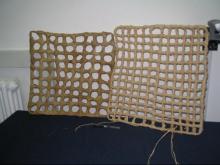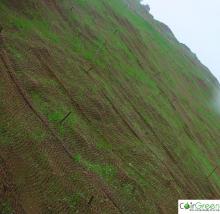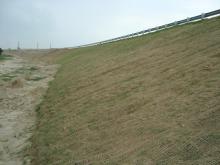Data provider
Budapest University of Technology and Economics, Department of Applied Biotechnology and Food Science, Environmental Microbiology and Biotechnology Group
Contact details
Compulsory sheet of the technology
Financing of the project
Application sphere
- Soil loss
- Soil erosion by water
- Chemical soil degradation
- Other
- Soil loss
- Soil erosion by wind
- *Physical soil degradation
- Decrease in moisture content
Information on the technology
A technológia lényege a talajerózió kontrollálása, útmenti lejtők eróziógátlása Borassus aethiopium, illetve Mauritia flexuosa pálmaleveleinek segítségével.A beágyazott matracokat fűmagokkal vetik be, vizsgálják a matracok vízmegtartó képességét. A matracok akadályozzák a megkötött víz párolgását, ugyanakkor elősegítik a fűmagvak növekedését, a csírázó növények át tudnak 'bújni' a matracon, így a talaj szervesanyagtartalmát növelik, a terület kedvezővé válik növényvilág és állatvilág számára egyaránt, emellett pedig védetté válik a terület a széllel, illetve az esővel, kimosással szemben. A technológia környezetbarát, biológiailag lebomló anyagokkal dolgozik.
A pálmalevelekkel való eróziógátlás jelenti az újdonságot: szintetikus geotextilek segítségével is akadályozhatjuk az eróziót, ám a pálmalevelekkel végzett technológia számos előnyt hordoz: nagyobb mennyiségű nedvességet képesek tárolni, illetve elősegítik az elvetett fűmagok növekedését (szintetikus rokonaikon nem tudnak átbújni a fejlődő csírák, a szintetikus matracot a fejlődő növények a talajfelszín fölé emelik), a kimosás és a kimosott üledék aránya, előfordulása kisebb.
Technology classification
- Soil amelioration with natural soil amendments
- Other natural soil amendment
Technology-monitoring
Costs of the technology
0,35-0,60 euró négyzetméterenként a pálma-matracok ára.
A költségek m2-re megadva.
SWOT (evalaution based on scores)
SWOT (evaluation in words)
A technológia erőssége az ára, illetve, hogy teljesen biodegradálható anyagokat használ, fenntartható, környezetbarát eljárás, azonnal alkalmazható. További előnye, hogy ipari lejtők talajának megkötésére speciális stratégia szükséges, ezeknek a speciális feltételeknek pedig a pálmaleveles technológia teljes mértékben megfelel.
A technológia viszonylag kiszolgáltatott az időjárás szeszélyeinek: a matracok csupán a kapott víz megkötésére képesek, illetve a talajterület beültetése időigényes.
A technológia népszerűbbé válása erdőirtások csökkentését, újraerdősítési akciók fellendülését idézheti elő. Új munkahelyeket teremthet, amelyet társadalmilag hátrányosabb helyzetbe kényszerültek is végezhetnek.
Nincs.
Completed applications
Size of the treated area
- Industrial
- Soil loss
- Soil erosion by water
- *Physical soil degradation
- Decrease in moisture content
- Soil loss
- Soil erosion by wind
Publications, references
Benediktas Jankauskas, Genovaitė Jankauskienė, Michael Augustine Fullen, Colin Anthony Booth: Utilizing palm-leaf geotextiles to control soil erosion on
roadside slopes in Lithuania, ¾emės ūkio mokslai.
http://tucson.ars.ag.gov/isco/isco15/pdf/Bhattacharyya%20R_Soil%20conse…
http://www.deepdyve.com/lp/elsevier/utilizing-palm-leaf-geotextile-mats…
Fullen M. A. Effects of grass ley set-aside on runoff, erosion
and organic matter levels in sandy soils in East Shropshire,
U.K // Soil & Tillage Research. 1998. Vol. 46. P. 12–26.
Fullen M. A., Catt J. A. Soil Management: Problems and
Solutions. London: Arnold, 2002. 269 p.
Fullen M. A., Arnalds A., Booth C. A. et al. Government and
agency response to soil erosion risk in Europe. In: Boardman
J., Poesen J. (eds.). Soil Erosion in Europe. Chichester:
John Wiley & Sons Publishers Ltd., 2006. P. 805–828.
Fullen M. A., Booth C. A., Sarsby R. W. et al. The potential
contribution of palm mat geotextiles to soil conservation
and sustainable development // Soil and Water
Conservation under Changing Land Use. Universitat de
Lleida Press, 2006. P. 303–306.
Jankauskas B., Fullen M. A. Lithuania. In: Boardman J.,
Poesen J. (eds.). Soil Erosion in Europe. John Wiley & Sons
Publishers Ltd, Chichester, England, 2006. P. 57–66.
Jankauskas B., Jankauskienė G., Tiknius A. The contribution
of quality assessment of eroded agricultural soil on
hilly-undulating landscapes to sustainable community development.
In: Petrosillo I. et al. (eds.). Use of Landscape
Sciences for the Assessment of Environmental Security.
Springer, 2008. P. 431–451.
M itchell D. J., Barton A. P., Fullen M. A. Effects of jute geotextiles
on runoff and sediment yield: field experiments
in the UK // Soil Use and Management. 2003. Vol. 19.
P. 182–184.


